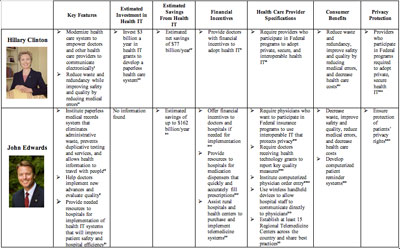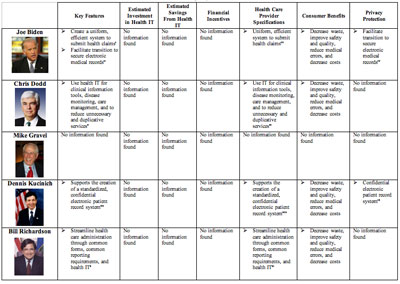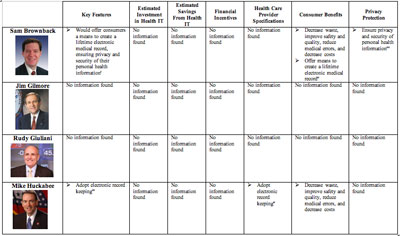By Susan J. Blumenthal, M.D., Jessica B. Rubin, Michelle E. Treseler*
As evidenced by the unique format of Monday night's Democratic Presidential debate, in which Americans submitted video questions to the candidates via the Web, technology has revolutionized all aspects of our lives. Supermarkets, businesses and banks utilize it, even children use it, but the incorporation of information technology (IT) in the practice of medicine is woefully lacking. Over 1.5 million Americans are injured and more than 100,000 die annually due to medical errors, and a recent study found that 80% of these mistakes began with miscommunication, missing or incorrect information about patients, or lack of access to patient records. The fact is that most health providers lack the information systems necessary to coordinate a patient's care with other providers, share needed information, monitor patient compliance, and measure and improve performance. In fact, in nearly one in seven visits, clinicians report that medical information integral to their patients' care is missing - a problem that was significantly less likely to be reported by physicians with access to patients' full electronic medical records. Additionally, a RAND study has revealed that despite spending twice as much on health care as any other nation -- 18% of our GDP -- Americans get the right treatment only 55% of the time, a problem that might be partially solved by health IT. It is also estimated that there is a 15 year science to service gap between the time of a new medical discovery and its wide dissemination in the community. In the Information Age, why shouldn't it be 15 seconds?
Currently, it is estimated that only 10-20% of health professionals and less than 25% of hospitals in the country use health information technology to reduce mistakes, increase efficiency, and decrease health care costs. It is estimated that if most health care providers adopted health IT the potential efficiency savings could average over $77 billion per year -- largely as a result of reduced hospital stays, reduced nurses' administrative time and more efficient drug utilization.
The bottom line: health information technology has an enormous potential to accelerate access to life-saving health information, to improve treatment outcomes, support evidenced-based care, reduce medical errors, empower patients, and decrease health care costs. However, barriers to the adoption of an interconnected health technology system still remain including how to resolve issues regarding patient privacy, the interoperability of information systems, health care provider licensing across state lines and potential liability issues. This article provides a side-by-side comparison of the Presidential candidates' proposals for incorporating information technology into their health plans** as one key component of moving the practice of medicine into the 21st century.
Chart #1: Side-by-Side Comparison of Leading Democratic Candidates' Health Information Technology Plans
Chart #2: Side-by-Side Comparison of Democratic Candidates' Health Information Technology Plans
*Susan J. Blumenthal, M.D., M.P.A., served as Assistant Surgeon General of the United States and Deputy Assistant Secretary for Health in the U.S. Department of Health and Human Services. She is a Clinical Professor at Georgetown and Tufts University Schools of Medicine and Distinguished Advisor for Health and Medicine at the Center for the Study of the Presidency (CSP) in Washington D.C.
Jessica Rubin, a junior at Yale University, is a health policy intern at the CSP. Michelle Treseler, a recent honors graduate of the College of William and Mary, serves as Special Assistant to Dr. Blumenthal at the Center for the Study of the Presidency.
**This article provides a detailed analysis, in chart form, of the Presidential candidates' current health information technology proposals, based on information provided on their websites (much of it in their own words) as well as from interviews and statements they have made to the press and in the debates thus far. For a complete overview of the candidates' health care proposals to date, please visit here. Readers are also encouraged to visit the candidates' websites listed below for more information and updates on the specifics of their health care proposals.
Please cite Susan J. Blumenthal, M.D., Jessica B. Rubin, and Michelle E. Treseler. U.S. Presidential Candidates' Health Plans: Incorporating Information Technology to Provide 21st Century Care. Huffington Post. 25 July 2007 in any future use of this material.
1 Woolf SH, Kuzel AJ, Dovey SM, Phillips RL Jr. A string of mistakes: the importance of cascade analysis in describing, counting, and preventing medical errors. Ann Fam Med. 2004;2:317-326.
2 RAND. (2005). Health Information Technology: Can HIT Lower Cost and Improve Quality. Santa Monica, CA: RAND, available here
3 Smith PC, Araya-Guerra R, Bublitz C, et al. Missing clinical information during primary care visits. JAMA. 2005;293(5):565-571.
4 McGlynn EA, Asch SM, Adams J, Keesey J, Hicks J, DeCristofaro A, Kerr EA. The Quality of Health Care Delivered to Adults in the United States, New England Journal of Medicine, Vol. 348, No. 26, June 26, 2003, pp. 2635-2645.
5 RAND. (2005). Health Information Technology: Can HIT Lower Cost and Improve Quality. Santa Monica, CA: RAND, available here
Links to Presidential candidates' health proposals/ websites (alphabetical list):
Joe Biden
Sam Brownback
Hillary Clinton
Chris Dodd
John Edwards
James Gilmore
Rudy Giuliani
Mike Huckabee
Duncan Hunter
Dennis Kucinich
John McCain
Barack Obama
Ron Paul
Bill Richardson
Mitt Romney
Tom Tancredo
